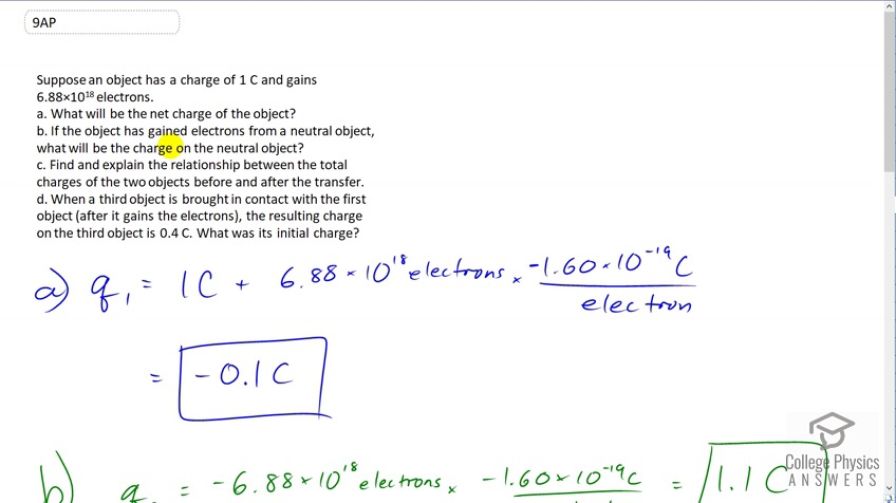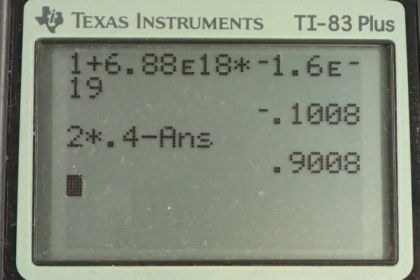Question
Suppose an object has a charge of 1 C and gains
electrons.
- What will be the net charge of the object?
- If the object has gained electrons from a neutral object, what will be the charge on the neutral object?
- Find and explain the relationship between the total charges of the two objects before and after the transfer.
- When a third object is brought in contact with the first object (after it gains the electrons), the resulting charge on the third object is 0.4 What was its initial charge?
Final Answer
- The total charge is always , demonstrating the law of conservation of charge.
Solution video
OpenStax College Physics for AP® Courses, Chapter 18, Problem 9 (Test Prep for AP® Courses)

vote with a rating of
votes with an average rating of
.
Calculator Screenshots
Video Transcript
This is College Physics Answers with Shaun Dychko. An object is initially positively charged with a charge of one Coulomb and it gains this many electrons. And the question is what will be the charge after it gains those electrons? So we'll call the charge Q1. So it's going to be the one Coulomb that it had initially plus the charge in Coulombs resulting from 6.88 times ten to the 18 electrons. And each electron has negative 1.6 times ten to the minus 19 Coulombs charge. And this makes a net charge of negative 0.1 Coulombs. Now if the object gained electrons from a neutral object, what will be the charge on the neutral object? Is the next question. So the neutral object we'll call that Q2. It's going to lose this many electrons. And so we'll put a negative sign there to indicate losing that many electrons and multiply it by the charge of each electron. And this works out to 1.1 Coulombs. And it will be positively charged since it has lost a bunch of electrons, which leave a bunch of unpaired protons. And so it has a positive charge. And then question c is find and explain the relationship between the total charges of the two objects before and after the transfer. So, the word total should make you think of the Law of Conservation of Charge. And so we'll add the two charges together before they're touching. And then we'll add the two charges together after the touching. So, before touching it's Q1 plus Q2 and first object has a charge of one Coulomb. And the second object has a charge of zero. So that's a total of one. And then after touching, charge two is zero by the way because the second object we're told is neutral. And then after they touch, it's Q1 prime plus Q2 prime is what's happening here. And so we have a net charge of negative 0.1 Coulombs in the first object and that's what we calculated in part a. And add to that, the 1.1 Coulomb charge of the second object. And this works out to one Coulombs, as well. These two totals are the same. And that is a law that has no exceptions found ever since somebody came up with it. And that is the Law of Conservation of Charge. So the total charge has to remain constant in any type of interaction and so could charge cannot be created nor destroyed. And so the total is always the same, it's just being moved from one place to another. And then part d says, when a third object is brought in contact with the first after it gains its electrons, in which case it has a charge of negative 0.1 Coulombs, the resulting charge on the third object we're told is positive 0.4 Coulombs, so what was its initial charge? Well, we know by the Law of Conservation of Charge that the total charge before and after contact has to be the same. And we also know that after contact, the charge on the first object will equal the charge on the third object because the charges will keep on transferring until the charge on both objects are the same. So, we can substitute, Q3 prime in place of Q1 prime here. And so we have two Q three prime. And then we'll subtract Q1 from both sides. And we get Q3, the initial charge on the thing that becomes positive 0.4 Coulombs on the end, is two times Q3 prime minus Q1. So this is two times 0.4 Coulombs minus the original chargeon the first object of negative 0.1 Coulombs. This works out to 0.9 Coulombs, must have been the charge on the third object before touching the first object.
